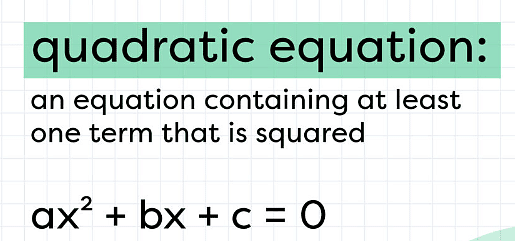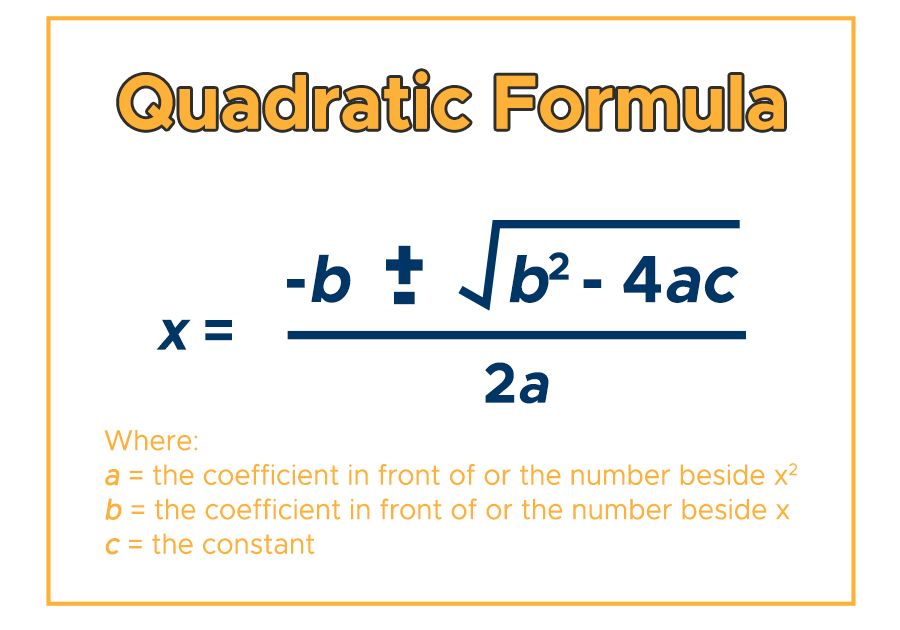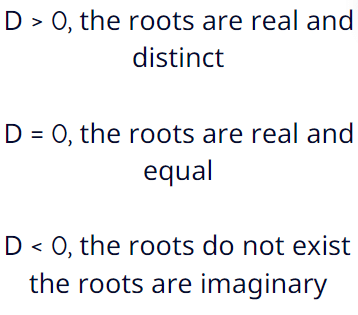Important Formulas: Quadratic Equations | Quantitative Aptitude (Quant) - CAT PDF Download
In the CAT exam, quadratic equations are crucial as they frequently appear in the quantitative aptitude section. Proficiency in solving quadratic equations is essential for mastering algebraic concepts and ensuring success in the quantitative reasoning portion of the exam. A solid understanding of quadratic equations enables candidates to solve complex mathematical problems efficiently, showcasing their quantitative abilities to excel in the CAT exam.

What are Quadratic Equations
- A quadratic equation is an algebraic equation of the second degree in x.
- The quadratic equation in its standard form is ax2 + bx + c = 0, where a and b are the coefficients, x is the variable, and c is the constant term.
- The important condition for an equation to be a quadratic equation is the coefficient of x2 is a non-zero term (a ≠ 0).
Roots of Quadratic Equation
- The roots of a quadratic equation are the two values of x, which are obtained by solving the quadratic equation.
- These roots of the quadratic equation are also called the zeros of the equation.
- For example, the roots of the equation x2 - 3x - 4 = 0 are x = -1 and x = 4 because each of them satisfies the equation. i.e.,
At x = -1, (-1)2 - 3(-1) - 4 = 1 + 3 - 4 = 0
At x = 4, (4)2 - 3(4) - 4 = 16 - 12 - 4 = 0 - There are various methods to find the roots of a quadratic equation. The usage of the quadratic formula is one of them.
Quadratic Formula

Example: Let us find the roots of the same equation that was mentioned in the earlier section x2 - 3x - 4 = 0 using the quadratic formula.
Sol: a = 1, b = -3, and c = -4.
x = [-b ± √(b2 - 4ac)]/2a
= [-(-3) ± √((-3)2 - 4(1)(-4))]/2(1)
= [3 ± √25] / 2
= [3 ± 5] / 2
= (3 + 5)/2 or (3 - 5)/2
= 8/2 or -2/2
= 4 or -1 are the roots.
Nature of Roots of the Quadratic Equation
- The roots of a quadratic equation are usually represented to by the symbols alpha (α), and beta (β).
- The nature of roots of a quadratic equation can be found without actually finding the roots (α, β) of the equation.
- This is possible by taking the discriminant value, which is part of the formula to solve the quadratic equation.
- The value b2 - 4ac is called the discriminant of a quadratic equation and is designated as 'D'. Based on the discriminant value the nature of the roots of the quadratic equation can be predicted.
Discriminant: D = b2 - 4ac

Sum and Product of Roots of Quadratic Equation
- Sum of the Roots: α + β = -b/a = - Coefficient of x/ Coefficient of x2
- Product of the Roots: αβ = c/a = Constant term/ Coefficient of x2
Writing Quadratic Equations Using Roots
- The quadratic equation can also be formed for the given roots of the equation. If α, β, are the roots of the quadratic equation, then the quadratic equation is as follows.
- x2 - (α + β)x + αβ = 0
- Example: What is the quadratic equation whose roots are 4 and -1?
- Solution: It is given that α = 4 and β = -1. The corresponding quadratic equation is found by:
x2 - (α + β)x + αβ = 0
x2 - (α + β)x + αβ = 0
x2 - (4 - 1)x + (4)(-1) = 0
x2 - 3x - 4 = 0
Important Formulas
- General Quadratic equation will be in the form of ax2 + bx + c = 0 The values of 'x' satisfying the equation are called roots of the equation.
- The value of roots, p and q

- The above formula is known as the Shreedhara Acharya's Formula, after the ancient Indian Mathematician who derived it.
- Sum of the roots = p + q = -b/a
- Product of the roots = p × q = c/a
- If 'c' and 'a' are equal then the roots are reciprocal to each other.
- If b = 0, then the roots are equal and are opposite in sign.
- Let D denote the discriminant, D = b2 - 4ac.
- Depending on the sign and value of D, nature of the roots would be as follows:
- D < 0 and |D| is not a perfect square: Roots will be in the form of p + iq and p - iq where p and q are the real and imaginary parts of the complex roots. p is rational and q is irrational.
- D < 0 and |D| is a perfect square: Roots will be in the form of p + iq and p - iq where p and q are both rational.
- D = 0 ⇒ Roots are real and equal. X = -b/2a
- D > 0 and D is not a perfect square: Roots are conjugate surds
- D > 0 and D is a perfect square: Roots are real, rational and unequal

Signs of the Roots
Let P be product of roots and S be their sum
- P > 0, S > 0 : Both roots are positive
- P > 0, S < 0 : Both roots are negative
- P < 0, S > 0 : Numerical smaller root is negative and the other root is positive
- P < 0, S < 0 : Numerical larger root is negative and the other root is positive
- Minimum and maximum values of a2 + bx + c = 0
- If a > 0: minimum value
 and occurs at x = -b/2a
and occurs at x = -b/2a - If a < 0: maximum value =
 and occurs at = -b/2a
and occurs at = -b/2a 
- Sum of the roots =

- Sum of roots taken two at a time =

- Sum of roots taken three at a time
 and so on Product of the roots
and so on Product of the roots 
|
166 videos|231 docs|95 tests
|
FAQs on Important Formulas: Quadratic Equations - Quantitative Aptitude (Quant) - CAT
| 1. What are the important formulas related to quadratic equations? |  |
| 2. How can you determine the signs of the roots of a quadratic equation? |  |
| 3. How can you find a quadratic equation given its roots? |  |
| 4. What is the significance of quadratic equations in real-life applications? |  |
| 5. How can one solve quadratic equations using the quadratic formula? |  |























